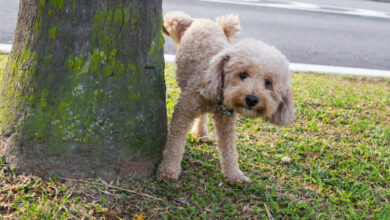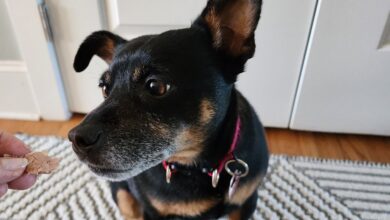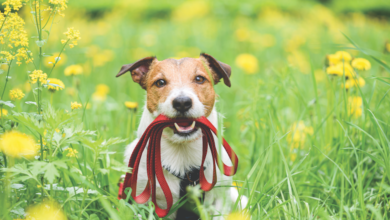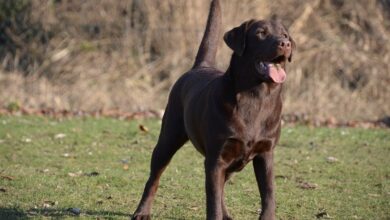Pup Got Skin Trouble? – Dogster
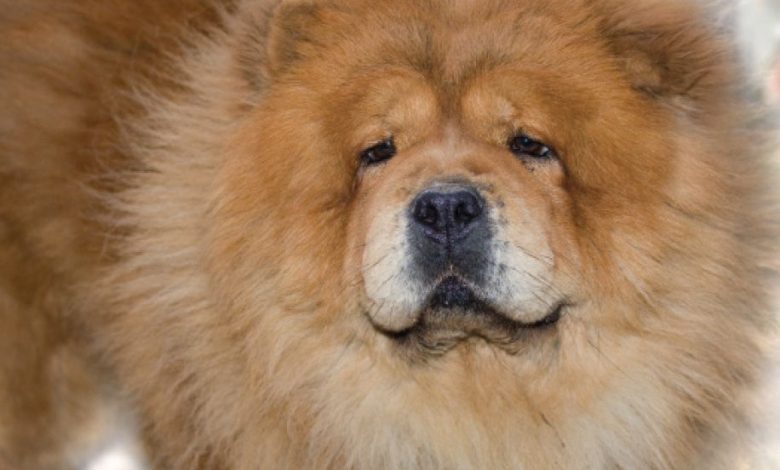
[ad_1]
Disclaimer: If you purchase items through links on our site we may earn a commission.
Dogs definitely put the capital D in diversity in terms of size, looks and temperaments. But the vitality of every dog of every age can be strongly linked to the health of his skin and coat. Quick anatomy lesson: A dog’s skin represents the largest organ, with the liver coming in a distant second. The three layers of skin — the epidermis (outer), dermis (middle) and subcutis (inner) team up to regulate body temperature, shield against infectious invaders, provide sensory information from the environment and much more.
“People can’t see the liver, pancreas or the bones in their dogs, so a disease, such as diabetes, can progress undetected for months,” says Dr. Lowell Ackerman, a board-certified veterinary dermatologist from Westborough, Massachusetts, who is a global veterinary consultant and author of several veterinary textbooks. “But when there is a problem with the skin, even a minor one, people are more apt to seek veterinary care for their dogs.”
The challenge, he says, is determining what is causing the rash, the bald spot, the swelling and the oily skin or dark spots. That’s why veterinary dermatologists often tap into their pet detective skills.
“Skin is only capable of certain changes, but there can be many causes,” Dr. Ackerman says. “Factoring the dog’s breed, age and when the skin issue started can definitely help us make the right diagnosis.”
Let’s take a closer look at these eight canine skin issues with a pair of experts from SeniorTailWaggers.com — Dr. Jamie Whittenburg, director of the Kingsgate Animal Hospital in Lubbock, Texas, and Dr. Debra Eldredge, an award-winning author of more than 20 pet books, including the Dog Owner’s Home Veterinary Handbook.
Hair loss
It can be widespread or in just one area on the body.
Possible causes: bacterial or fungal infection, Cushing’s disease, hypothyroidism, parasites, allergies to food or plants, autoimmune disorders or seasonal flank alopecia.
Solutions: “Hair loss in dogs is often due to an endocrine disease, such as Cushing’s or hypothyroidism,” says Dr. Whittenburg. “Fungal infection can be treated with oral medications, dips or shampoos. Allergies cannot be cured, but can be controlled through medications, shampoos and special diets. Melatonin can be given to aid in hair regrowth for dogs who suffer from seasonal flank alopecia. There are many treatment options for dogs with autoimmune disorders.”
Red skin bumps
They can be similar to a rash on a dog’s skin, but more likely to appear even on haired areas. You tend to notice their presence before seeing them.
Possible causes: Itchy skin bumps are usually due to allergies or insect bites from black flies, mites and lice. They can also be initial symptoms of bacterial infections.
“If the bumps are accompanied by a moist discharge or erosions in the skin, you should contact your veterinarian right away,” Dr. Eldredge says. “The same is true if your dog is in respiratory distress, as these bumps may be hives and indicative of a potentially serious allergic reaction.”
Solutions: A veterinary exam will include skin scrapes, impression smears and, possibly, a skin biopsy to aid in identifying the cause. Treatments can range from medicated shampoos to antibiotics to corticosteroids.
Crusty skin
The dog may also be itchy.
Possible causes: The presence of parasites like fleas, lice and mites as well as autoimmune disorders, allergies, bacterial or fungal infections or dry skin are some causes, according to Dr. Whittenburg.
Solutions: Year-round administration of parasite medications, medications to fortify the immune system, medicated shampoos to address allergies and adding oral fatty acid supplements and moisturizing shampoo to combat dry skin.
Flaky skin that is dry or oily
These conditions — called seborrheic dermatitis — come in dry and oily forms.
Possible causes: This disease can be genetic and is common in Cocker Spaniels, West Highland White Terriers and Basset Hounds,” Dr. Eldredge says. “Any dog may develop this condition secondary to another issues.”
Solutions: Both dry and oily forms are treated with medications and skin supplements.
Itchy skin
This skin condition ranks as a major reason dogs are brought to veterinarians to address the dog’s constant pawing at his skin and rolling on the ground for relief from itch. Or the dog will be shaking his head or scratching one or both ears.
Possible causes: The presence of fleas or ticks, allergies, ear infections and dry skin top the reasons for itchy skin.
Solutions: “Testing is needed to determine the cause of the itching, and that could include skin scraping, bloodwork, skin biopsies, cultures and ear cytology,” Dr. Whittenburg says. “Medications, shampoos and diet can be used to control dog allergies, while oral supplements and medicated shampoos can help moisturize the skin and stop the itch.”
Black spots
Also known as hyperpigmentation, they can be widespread or limited to small spots on the skin. It tends to be a secondary condition.
Possible causes: Skin trauma, skin cancer, hypothyroidism or aging top the list.
“To find the cause of hyperpigmentation, your veterinarian will perform biopsies and blood work after obtaining a thorough history and doing a physical examination,” Dr. Whittenburg says. “We find that as dogs age, especially Schnauzers and Dachshunds, the skin on their chests and abdomens may darken. This is harmless and normal for many older dogs.”
Solutions: Depending on the identified cause, a dog is treated with medicated shampoos, thyroid supplements, immunosuppressants or steroids.
Bad-smelling hair & skin
Most of the time, the stinky smell is benign.
Possible causes: The stinky smell may be caused by your dog rolling and rubbing in deer feces or other dog feces during a walk in the woods or because he got sprayed by a skunk. Or it may be due to the fact that he has not had a proper bath in months.
Solutions: Get in the habit of regularly inspecting your dog’s coat for any dried, stinky materials. Check with your veterinarian on selecting the right shampoo best suited for your dog’s type of coat.
Your dog’s skin and hair work overtime and take on many vital duties, no matter if he is a nearly hairless breed like a Chihuahua or a major fluff ball like an Old English Sheepdog. With these solutions, you can stay on top of skin issues to keep your dog comfortable in his own skin.
Red rashes

Usually there is no discharge present with this reddish patch on the skin.
Possible causes: “A red rash is often an allergic reaction to things like insect bites or as a result of a contact dermatitis reaction,” Dr. Eldredge says. “Think about anything you have changed in your household, such as a new rug or a new floor cleaning product or a new detergent used to wash your dog’s bed.”
However, if the rash is moist, than yeast may be the leading culprit.
Solutions: Expect your veterinarian to do a thorough check on your dog for the presence of parasites. Skin scrapes may be used to rule out various mange mites. An itchy rash may benefit from a medicated shampoo while topical or oral steroids may be needed to address your dog’s discomfort. Antibiotics or antifungal medications may be prescribed if bacteria or yeast are found.
“If the rash is widely distributed and not itchy, you may actually be seeing areas of ecchymosis (small hemorrhages) under the skin,” Dr. Eldredge adds. “This may represent an autoimmune disease or a bleeding disorder and is a concern for immediate veterinary attention.”
Help for Skunk Stink

Dr. Eldredge shares this home remedy:
In a bucket, mix:
- 1 to 2 teaspoons of mild dishwashing detergent (Note: Use just for skunk stink as can strip dog’s skin of natural oils.)
- ¼ cup baking soda
- 1 quart of 3% hydrogen peroxide solution
Work the foaming mixture well into the coat and leave on for five minutes. Rinse thoroughly with warm water and follow up with dog shampoo if desired.
“If your dog is squinting and may be sprayed in the face and eyes, you need to see your veterinarian,” she adds. “Otherwise, a cleansing or two at home should be all you need.”
Get the skinny on skin products
Give your dog’s skin some love, as good skin — whether for dogs or humans — takes a little work. Here are a few products available today that do just that.
Spina Organics Daily Facial Cleanse; $17.50 This tear-, alcohol- and rinse-free cleanser uses micellar water to attract and trap dirt and debris, plus has anti-inflammatory, antispasmodic, antifungal and insecticidal properties.
Earthbath Oatmeal & Aloe Grooming Wipes; $9.99 Clean your pup between baths with these vanilla and almond scented, soothing, plant-based wipes made for dogs with itchy, dry skin.
WashBar Paw Balm — Kanuka & Repair; $14.99 Essential oils blend with beeswax to soothe and moisturize paws. The balm doesn’t contain harsh chemicals, synthetic fragrances, colors, sulfates or parabens.
Zymox Shampoo; $17.11 A soothing and nourishing formula that blends enzymes, protein and Vitamin D for gentle cleaning and healthy skin support, plus great for itchy, irritated or inflamed skin.
[ad_2]
Source link


